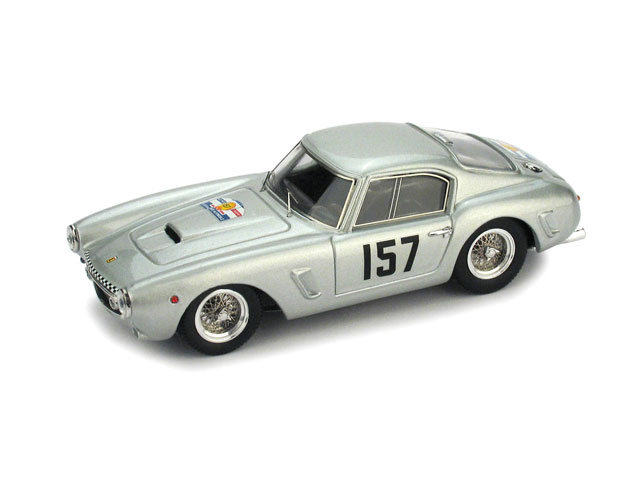|
Ecurie Francorchamps official collection
|
|
 |
|
|
EF13 Limited edition 500pcs. Prodotto da / manufactured by Bang srl |
|
|
EF13 FERRARI 250 GT BERLINETTA PASSO CORTO ( telaio/chassis 02129 )
( I ) Il Mito Ferrari si è costruito sulla base di un motore dodici cilindri progettato dall’ingegner Gioachino Colombo nel 1947 inizialmente di solo un litro e mezzo di cilindrata ed in seguito evoluto fino alla sua migliore espressione in tre litri. Il debutto in gara avviene nel 1952 alla Mille Miglia, motorizzando una berlinetta carrozzata da Vignale che condotta magistralmente sotto la pioggia da Giovanni Bracco ottiene per la Ferrari la quarta vittoria consecutiva. Nel 1955 questa unità motrice fa la sua apparizione in una prima serie di berlinette carrozzate da Scaglietti note come Berlinetta Competizione a passo lungo (2600 mm) e prodotta in più varianti fino al 1959. Successivamente il passo viene accorciato a 2400 dando vita alla serie detta a passo corto. Una delle classiche competizioni su strada e circuito del tempo era il Tour de France, che nel mese di settembre faceva scorrazzare per mezza Europa le migliori gran turismo condotte dai più noti piloti del periodo. La Ferrari con il suo modello 250 GT Berlinetta Competizione si era aggiudicata le edizioni del 1956, con Alfonso De Portago e Nelson, e del 1957,1958 e 1959 con Bianchi e Gendebien. L’edizione del 1960 vede il debutto della versione a passo corto, presente con ben sette equipaggi. L’Ecurie Francorchamps di Jacques Swaters vi partecipa con tre vetture: la 01965 di Dubois e Van de Velde con il numero 255, la 02149 condotta da Bianchi e Gendebien, vincitori delle tre precedenti edizioni della gara con il numero 152, e la 02129 per Georges detto Jojo Berger e Willy Mairesse con il numero di gara 157. Durante tutti i 5500 km di gara non si sono risparmiati né i piloti né i mezzi, ed alla fine ha prevalso Mairesse sul più esperto Gendebien, a causa della rottura di un pistone sull’argentea berlinetta numero 152. Alla vettura vincitrice è stato sostituito il cambio in parco chiuso, mentre i piloti intrattenevano i commissari sportivi! Veramente altri tempi. ( GB ) The driving force behind the Ferrari legend was a 12-cylinder engine designed by Gioachino Colombo in 1947, initially only a one and a half-litre unit that was later developed to become a real world beater in the three-litre version. It made its racing debut in 1952 in the Mille Miglia, when it equipped a berlinetta with a Vignale body, a car driven superbly in the pouring rain by Giovanni Bracco who chalked up the fourth consecutive win for Ferrari. In 1955 this power unit made its appearance in an initial series of cars with bodywork made by Scaglietti, known as the long wheelbase (2600 mm) Berlinetta Competizione, which was produced in a number of versions up to 1959. Later the wheelbase was shortened to 2400 mm, hence the name for this series. One of the classic road and circuit races at the time was the Tour de France, that in the month of September saw top gran turismo cars driven by leading drivers doing battle throughout Europe. Ferrari had won the 1956 edition with its 250 GT Berlinetta Competizione model driven by Alfonso De Portago and Nelson, and went on to win again in 1957,1958 and 1959 with Bianchi and Gendebien. The 1960 edition saw the debut of the short wheelbase version with fully seven teams in the line-up. Jacques Swaters Ecurie Francorchamps team participated with three cars: chassis 01965 with Dubois and Van de Velde with race number 255, the 02149 driven by Bianchi and Gendebien, winners of the three previous editions and this time with race number 152, and the 02129 for Georges, known as Jojo Berger and Willy Mairesse with race number 157. These three battled it out over the entire 5,500 kilometre race and in the end it was Mairesse who got the better of the more expert Gendebien, whose silver berlinetta number 152 broke a piston. The gearbox of the winning car was replaced in the paddock while the drivers chatted away with the race officials! Certainly these were other times. |
|
